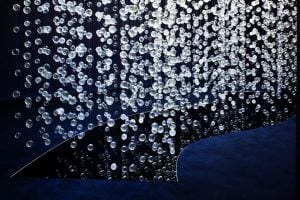“Analogue of God”. Solo exhibition by Dmitry Shorin. In the early 2000s Dmitry Shorin announced himself as the author of a new contemporary artistic language. His work stood out against the other contemporaries, who were still striking for the ideas of nonconformity and aesthetics of neo socialist realism. Shorin’s language was simple and straightforward, therefore it attracted a broad audience. The artist generously enriches his paintings with mass-media, entertainment, and glamour features. His visual method is cinematic: each painting is a kind of a still frame. You feel motion, rhythm, and at the same time see the details, since it is static. Using easy for understanding and citing tools of mass culture, the artist creates a world far more complex than its external form. His main heroes are glossy and fragile young girls placed in the context of harsh reality. They are still unattainably gorgeous, but seem much closer to the viewer: they breathe, feel, and suffer from physical pain. Shorin breaks the boundaries between the elite, beautiful and mass scale. Likewise a film director, he makes the reality to obey his own rules turning the intelligent and complex into simple, at least outwardly. The viewer always has the opportunity to find what he’s been searching for.
Visual appeal of Shorin’s canvases doesn’t obscure his intention for deep philosophical understanding of life. Each of his projects “Girls from the Next House” (2003), “Appetite” (2004), “Time not Forever” (2006), “Holidays” (2011) “We are (not) Alone” (2012), “Private Space” (2013), etc. opens to the viewer a whole new world, flavored with irony, brightness, sensuous temperament, natural sexuality, lust for life, pleasure, and consumption. Shorin keenly feels reality, serving this dish under the rich sauce of glossy aesthetics.
“Analogue of God” reveals the topic of totemism and fetishism. Modern urban dwellers drown and lose themselves in constant information flows. To get back on their own way they need a lighthouse, Something or Someone, who will keep them afloat. In ancient times, this role was given to stone statues of pagan deities. Today it can be anything from professional occupation to a beloved person, who we admire as a saint.
“People feel lonely and abandoned without adoration of the great and the unknown, — says Dmitry Shorin. — From ancient gods to shamanic spirits. From handmade cult things to sainted personalities. From phantasmagoria to fetish and even calendar events. When we are children we are ready to sell our soul for a ride in the neighbor’s pedal car. Growing up, we die for a record of ‘Rolling Stones’ or a new bike. And as adults we try to saint the art or the beloved ones. Sometimes a glance to the sky and realizing of universal riot inspires us to faith”.
Dmitry Shorin
Dmitry Alexandrovich Shorin is a Russian artist and sculptor. Dmitry is the youngest contemporary artist honored with an solo exhibition in Marble Palace of State Russian Museum and a Kandinsky Prize nominee.
He studied art in Omsk State Pedagogical University and moved to Saint Petersburg to finish his education and graduate from local academy as a costume designer. From then on he lives and works in Saint Petersburg. Shorin is a member of «Free Culture» Society, a non-commercial association of underground artists that hold his first exhibitions back in 1994—1996, and a member of UNESCO International Federation of Art.
Erarta Museum of Contemporary Art
Erarta is the biggest global project in Russian contemporary art, a must-see institution for gaining insight into modern Russia. At the heart of Erarta lies a totally unique approach to both the art and the viewer, a desire to build a new relationship system between people and art. The museum’s absolute focus and priority are concentrated on the most important person at Erarta – the visitor. All of Erarta’s activities are aimed at growing the number of people who appreciate and love contemporary art because at the core of the institution lies a belief that love of art can make any individual’s life more interesting and fulfilling, thus, ultimately, spreading a passion for art makes the world a happier place.
Erarta is Russia’s largest private museum of contemporary art, a must-see place for gaining insight into modern Russia. Its permanent collection featuring over 2,800 works by Russian artists, along with more than 40 exciting temporary exhibitions staged by the museum every year, have firmly established it on the list of things to do in St. Petersburg. Erarta Museum of Contemporary Art was repeatedly mentioned as a top choice tourist attraction by Lonely Planet guidebooks; ranks among the top 10 museums in Russia on TripAdvisor; was spotlighted as one of the ‘5 Cultural Gems’ among places to visit in St. Petersburg by National Geographic, and became the country’s first contemporary art museum to be featured on Google Arts and Culture Project.
In St. Petersburg, one of the wings of its 10,000 sq. m building is dedicated to the permanent exhibit of the collection of Erarta Museum, the largest private museum in Russia, containing 2800 works by more than 300 artists from all over the country. Another two wings are dedicated to temporary exhibitions and change completely every three months, with over 35 shows in total staged each year. There is also a multi-function Erarta Stage performance hall with a maximum occupancy of 800, which every year hosts over 300 various events such as plays, concerts and film screenings as well as lectures and meetings with renowned figures from the worlds of art, fashion and design. Erarta is open every day except for Tuesdays, from 10:00 till 22:00








